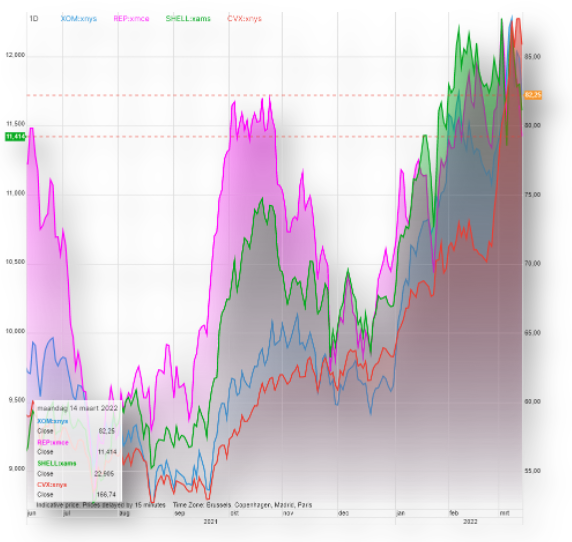Petrol prices through the roof!
Wherever you go at the moment, everyone is talking about the high petrol prices and how this is directly felt in the wallet. Can you respond to this as an investor, and how was I asked again today?
In this column, I will briefly present three possibilities how you, as an investor, can respond to a rising oil price. I will start with the more complicated option and conclude with the easier one.
Number 1. The other day we had a gentleman in the office who said: “I would like to buy a couple of barrels of oil… ”. Unfortunately, it is still not possible to reserve a few barrels of oil somewhere in a harbor or a refinery!
Most trading in oil takes place on the market through futures contracts. The most popular are Brent Crude and Light Sweet Crude Oil. But beware, before you let yourself be tempted to immediately take a position in a future, it is important that you realize that these contracts have a number of characteristics that can influence your degree of success while trading. First of all, there is the contract size; if you buy one future contract on Brent Crude or Light Sweet Crude you will have 1000 barrels of oil in your possession.
Secondly, you must take into account the fact that the future contract has an end date. With futures, it is always the case that the contract expires around 1 month prior to expiration. That means that, for example, the future contract for the month of May already expires in April. Together with the expiration date, it is of importance that you realize that the future price of a barrel of oil could be higher or lower than the current price. This can cause your position to suddenly become loss-making because your position has to be shifted to a later expiry date. When the future price is higher than the current spot price, we speak of Contango, and when the price is lower, of Backwardation.
A 2nd possibility to respond to a rising oil price is by buying oil-related companies. As the product these companies sell, oil, becomes more expensive, this generally has a favourable effect on the price of these companies. Below you can see a graph of the price development of the companies Exxon, Repsol, Shell, and Chevron.

You can see that these companies, as well as Brent Crude Oil and Light Sweet Crude Oil, all show a rising pattern (picture below). The advantage of buying shares is that you will also receive a dividend of about 3-4% per year.

Number 3. Finally, you can also opt for a simpler solution by buying an Exchange-Traded Fund (ETF), an ETF is a basket of shares that follow a certain index. The largest and best-known ETF is U.S.O., short for United States Oil Fund, which aims to track the price of Light Sweet Crude Oil as closely as possible. As a counterpart to this ETF, you can opt for the BRNT or also the WisdomTree Brent Crude Oil ETF, which is designed to follow the Bloomberg Brent Crude Subindex. However, with these two ETFs you should bear in mind that you are investing in futures, so you may have to deal with the Contango and Backwardation as explained earlier.
If you prefer to invest in companies that operate in the oil sector, you can always opt for an ETF in oil and gas companies. If you are looking for European equities, you can choose the Lyxor STOXX Europe 600 Oil & ICBE ETF, for example. If you prefer to invest in US oil and gas companies, you can opt for the iShares Oil & Gas Exploration & Production UCITS ETF. As you can see, investing in oil is not as simple as you might initially expect. Whether you choose a future, an individual share or an ETF, be alert that you do your homework well so you know exactly what your potential risks are.
The information in this article should not be interpreted as individual investment advice. Although Hugo compiles and maintains these pages from reliable sources, Hugo cannot guarantee that the information is accurate, complete or current. The use of information from this article without prior verification or advice is at your own risk. We recommend that you only invest in products that match your knowledge and experience and do not invest in financial instruments whose risks you do not understand.


